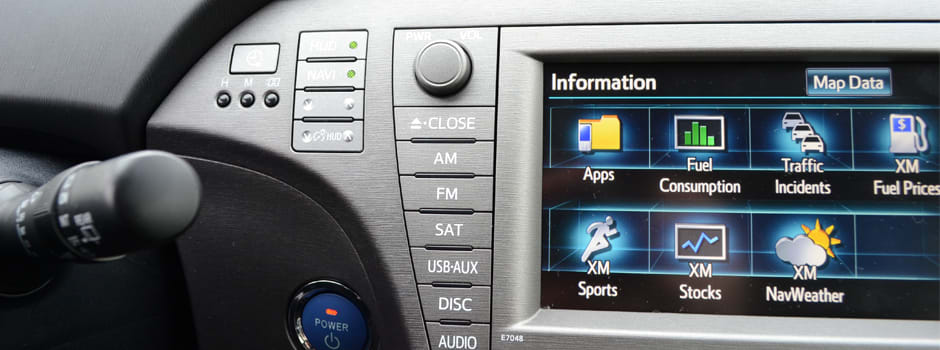Introduction
If you consider yourself an overachiever, we've got the car for you.
While the rest of the world is impressed with any car that can manage above 30, you'll be getting about three times that. And if you have a particularly short commute, you may not use any gas at all. The catch: It's initially only available in Arizona, California, Connecticut, Hawaii, Maine, Maryland, Massachusetts, New Hampshire, New Jersey, New York, Oregon, Rhode Island, Vermont, Virginia and Washington.
If fuel economy isn't a top concern, this car likely won't get you too excited. And there's the issue of needing a place to plug in. But if you're looking at hybrids anyway, take a look at some of the lease deals Toyota has on offer — it may end up cheaper than a regular Prius depending on how much gas you use.
Tech & Entertainment
Telematics matters when your car plugs in.
The Prius Plug-In comes in fewer trim levels than the conventional Prius hybrid, meaning that owners will always have navigation and Entune, Toyota's suite of apps that piggyback on your smartphone's data plan.
We highly recommend stepping up to Entune and connecting your phone. Since it can take advantage of Microsoft's Bing search engine, it allows for better point of interest location and one-shot voice recognition for addresses. Toyota's factory nav system is okay, but it lags far behind Entune. Integration is lacking, though: if you don't have your phone connected and specifically request a destination in Bing through Entune on the touchscreen, the default choice is the factory nav.
We drove the Prius Plug-In Advanced, which features Plug-in Hybrid Applications. After a one-time registration, it'll help you find a charging station, monitor the state of a charge, turn on the AC while the car is plugged in, and e-mail you when the batteries are topped off. It'll also alert you if something goes wrong.
It's a perfect example of how telematics can markedly enhance the experience of driving an EV. We plugged in at a shopping center and went to lunch, returning after we got an e-mail alerting us that the car was charged. It was off for another eleven miles or so of gas-free driving.
Unfortunately, the Plug-in Apps had a few hiccups. First off, you can only search for charging stations while the vehicle is in park. It's understandable that Toyota wants to minimize driver distraction, but EV owners often have to make decisions on the fly in order to find a nearby charge. That's less of an issue for a plug-in hybrid, but still an annoyance.
Second, the remote climate app would be better named "remote AC," as it doesn't allow users to turn on the car's heat. That's an issue in cold climates, since the Prius' engine will run to warm up the car even if the batteries are fully charged.
Design
The exterior is the same as a conventional Prius. That's a good thing.
Toyota didn't make any fundamental changes to the exterior of the Prius when they made it a plug-in. That's a good thing, since it has tons of interior space for passengers and cargo. It's a little narrow, so squeezing someone in the middle rear seat may not be the most polite choice, but four adults get plenty of room for legs and luggage.
About the only visible exterior change is the addition of a standard charging socket to the rear fender opposite the gas filler. Plug in, and you'll get around eight to eleven miles of electric-only driving. If you're plugging into a standard 120V outlet, you'll get that recharge in about three hours. With a 240V outlet, it takes about an hour and a half. Under the trunk floor, there are upgraded lithium-ion batteries that can handle the power demands of electric-only driving. Unless you drive into the world's largest table saw, you'll never see them.
The flashier hybrid owners will appreciate special plug-in only colors, and specific exterior trim and badging. We think it's unfortunately reminiscent of the early-'90s craze of festooning high trim level cars with giant "4x4" and "Special Edition" badges.
{{photo_gallery "design"}}
Driving Experience
Toyota didn't make any changes from the conventional Prius. That's not necessarily a good thing.
Aside from a few minutes of silence after plugging in, there's almost no discernible difference between the plug-in Prius and the conventional car. In other words, it's tuned for fuel efficiency, not performance.
You'll find that acceleration isn't brisk, and the steering feel is numb. Of course, you'll be getting at least double the fuel economy of the majority of other cars on the road. If your driving consists of weekday slogs, it's perfect. And you'll save enough money on gas to buy a used early-'90s Miata for fun weekend drives.
We're not going to wade into the "long tailpipe" issue here in great depth, but suffice it to say that the Plug-in Prius' environmental benefits can depend on how long you keep the car, what you're replacing, and whether your local utility connects you with a wind farm or a coal-fired power plant. Still, saving gas is generally a very good idea.
Conclusion
If you've got a plug, consider this Prius
So often, the Prius gets a bad rap because of mismatched expectations. Let's dispense with them forthwith: A Prius will never win a drag race, singlehandedly save a family of polar bears, or cost less than a base Corolla. But a Prius will give you a decent amount of interior space, a lot of tech, and extremely high gas mileage at a reasonable price.
With upgraded batteries that can take a charge from plugging in, the Prius Plug-in makes the existing car even better. And depending on favorable tax incentives, well-packaged options, and attractive lease deals, buying one may be a good value. Just make sure you've got somewhere to plug it in.
Trim Levels
Toyota made it easy here. There's a base Prius Plug-in, which comes very nicely equipped with heated front seats, keyless entry and ignition, navigation, and Entune. The MSRP is $32,000, but tax incentives and lease deals often make it competitive with a non-plug-in.
You can step up to the Prius Plug-in Advanced, which adds a better sound system, imitation leather seats, dynamic radar-based cruise control, and Prius Plug-in Hybrid Applications.
Powertrain
Though it's got a plug, this car is still a hybrid. You can drive it without ever plugging in. But you do have to fill it with gas. It's front-wheel drive and has a continuously variable transmission (CVT) — no options there.
Safety
If you've ever doubted whether small changes to car designs can make a big difference, here's your proof: The Plug-in has a slightly heavier battery pack than the regular Prius. As a result, NHTSA gives the conventional Prius five stars, but the Plug-in only four. Side impact ratings are the same.
The Insurance Institute for Highway Safety tested a 2012 Toyota Prius Plug-in and gave it a Top Safety Pick, along with an overall rating of "Good" — the agency's top rating.
Fuel Economy
Since electric power isn't measured in gallons, the EPA does some math and gives the Plug-in Prius an estimated fuel economy of 95 miles per gallon equivalent for drivers who regularly plug in their Plug-ins. If you were to never open the charging port, you'd get a still-respectable 50 mpg.
Meet the tester
Keith was the Editor in Chief of Reviewed's appliance and automotive sites. His work has appeared in publications such as Wired, Car & Driver, and CityLab.
Checking our work.
Our team is here to help you buy the best stuff and love what you own. Our writers, editors, and experts obsess over the products we cover to make sure you're confident and satisfied. Have a different opinion about something we recommend? Email us and we'll compare notes.
Shoot us an email

